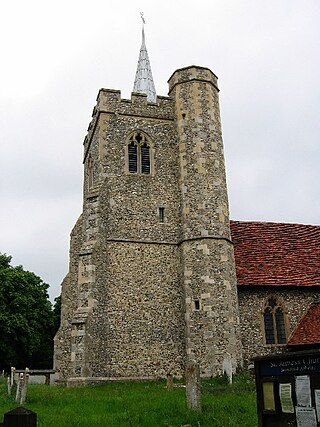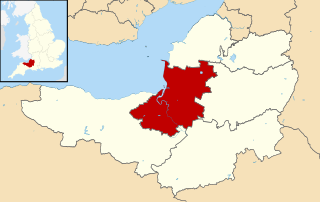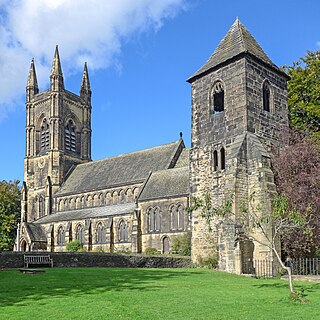
The Church of St Mary the Virgin, widely known as St Mary Redcliffe, is the main Church of England parish church for the Redcliffe district of the city of Bristol, England. The first reference to a church on the site appears in 1158, with the present building dating from 1185 to 1872. The church is considered one of the country's finest and largest parish churches as well as an outstanding example of English Gothic architecture. The church is so large it is sometimes mistaken for Bristol Cathedral by tourists. The building has Grade I listed status, the highest possible category, by Historic England.

West Lavington is a village and civil parish in Wiltshire, England, on the north edge of Salisbury Plain, on the A360 road between Devizes and Salisbury, about 5 miles (8 km) south of Devizes. The parish includes the hamlet of Littleton Panell.

St Mary's Church, Handsworth, also known as Handsworth Old Church, is a Grade II* listed Anglican church in Handsworth, Birmingham, England. Its ten-acre (4 hectare) grounds are contiguous with Handsworth Park. It lies just off the Birmingham Outer Circle, and south of a cutting housing the site of the former Handsworth Wood railway station. It is noteworthy as the resting place of famous progenitors of the industrial age, and has been described as the "Cathedral of the Industrial Revolution".

Edington Priory in Wiltshire, England, was founded by William Edington, the bishop of Winchester, in 1351 in his home village of Edington, about 3+3⁄4 miles (6 km) east of the town of Westbury. The priory church was consecrated in 1361 and continues in use as the parish church of Saint Mary, Saint Katharine and All Saints.

All Saints Church is in Church Lane, Marple, Greater Manchester, England. It is recorded in the National Heritage List for England as a designated Grade II listed building. In the churchyard is the tower of an earlier church, which is also listed at Grade II. The church is an active Anglican parish church in the diocese of Chester, the archdeaconry of Macclesfield and the deanery of Chadkirk.

The Church of All Saints in East Pennard, Somerset, England, dates from the 14th century. It is a grade I listed building.

The Church of St Andrew in Chew Magna, Somerset, England dates from the 12th century with a large 15th-century pinnacled sandstone tower, a Norman font and a rood screen that is the full width of the church. It is a Grade I listed building.

St James' Church is a redundant Anglican church near the village of Stanstead Abbotts, Hertfordshire, England. It is recorded in the National Heritage List for England (NHLE) as a Grade I listed building, having been designated in 1967. The church is under the care of the Churches Conservation Trust. The church is about 1 mile (1.6 km) to the southeast of the village on the north side of the B181 road. It stands on the top of a hill overlooking the Lea marshes.

Old St Andrew's Church, Kingsbury, is a Romanian Orthodox and former Anglican church in Kingsbury in the London Borough of Brent, Greater London, England. It is recorded in the National Heritage List for England as a designated Grade I listed building, and is under the care of the Churches Conservation Trust.

All Saints is a parish church in Maidstone, Kent. It is a Grade I listed building, and has been described as the grandest Perpendicular style church in Kent.

St James, Norton is the Church of England parish church of the Norton district of Sheffield, South Yorkshire, England.

All Saints Church is in the village of Berrington, Shropshire, England. It is an active Anglican parish church in the deanery of Condover, the archdeaconry of Ludlow, and the diocese of Hereford. Its benefice is united with those of twelve other parishes to form the Wenlock Team of Parishes. The church is recorded in the National Heritage List for England as a designated Grade I listed building.

North Somerset is a unitary authority in the ceremonial county of Somerset, England. As a unitary authority, North Somerset is administered independently of the non-metropolitan county of Somerset. Its administrative headquarters are located in the town hall of Weston-super-Mare.

Sedgemoor is a local government district in the English county of Somerset. In the United Kingdom, the term listed building refers to a building or other structure officially designated as being of special architectural, historical or cultural significance; Grade II* structures are those considered to be "particularly significant buildings of more than local interest". Listing was begun by a provision in the Town and Country Planning Act 1947. Once listed, severe restrictions are imposed on the modifications allowed to a building's structure or its fittings. In England, the authority for listing under the Planning Act 1990 rests with Historic England, a non-departmental public body sponsored by the Department for Digital, Culture, Media and Sport; local authorities have a responsibility to regulate and enforce the planning regulations.

The Anglican Church of St Catherine at Montacute within the English county of Somerset was first built in the 12th century. It is a Grade II* listed building.

St James's Church is the main Church of England parish church for the town of Trowbridge, Wiltshire, England. The 15th-century Grade I listed building is the town's most prominent landmark.

The Anglican Church of St Andrew Compton Dundon, Somerset, England was built in the 14th century. It is a Grade II* listed building.

The Anglican St Lawrence Church, dedicated to St. Lawrence of Rome, is the Church of England parish church of Lechlade in Gloucestershire, England. The church building is Grade I listed and is described with admiration in Simon Jenkins's England's Thousand Best Churches.

St Mary's Church is the parish church of the town of Mirfield in West Yorkshire, England. The current building is a large Gothic Revival structure designed by Sir George Gilbert Scott, replacing an older structure, the tower of which still survives a short distance from the present building. These structures form Mirfield's most prominent landmark and both are listed for preservation by Historic England, the old church tower as Grade II and the present building as Grade II*.

St Giles' Church is an active parish church in the village of Stoke Poges, Buckinghamshire, England. A Grade I listed building, it stands in the grounds of Stoke Park, a late-Georgian mansion built by John Penn. It is famous as the apparent inspiration for Thomas Gray's poem Elegy Written in a Country Churchyard; Gray is buried in the churchyard.





















